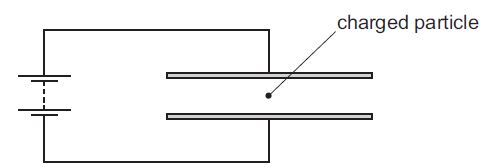Millikan’s Experiment With An Oil Drop Of Radius For Cambridge A Level

So, the American scientist Robert Millikan devised an ingenious way to do it. He observed electrically charged droplets of oil as they moved in electric and gravitational fields and found that they all had a charge, a small integer multiple of a particular value, which he took as the charge on a single electron e. Having established a value for e, he could easily combine this with Thomson’s value of e/me to calculate the electron mass (me).
I will answer questions about Millikan’s experiment with an oil drop of radius R in this article. The charge of an electron is very small (1.60 x 10-19 C) and difficult to measure.
Read: Solved questions on Electric Field
Questions
Question 1: In Millikan’s experiment, an oil drop of radius 10−4cm remains suspended between the plates which are 1 cm apart. If the drop has charge of 5e over it, calculate the potential difference between the plates. The density of oil may be taken as 1.5gcm−3
Solution
Kindly note that in Millikan’s experiment FG = FE
FG = is the gravitational force
FE is the Electric Force
In two parallel plate, E = V/d, also E = F/q
E is the electric field strength
V is the potential difference between the plate
D is the distance between the plates
Q is the charge
V/d = F/q
Fd = Vq
V = Fd/q
F (force) = Mg
To calculate the mass, density = mass/volume
Volume of a sphere = 4/3 x pi x r3 = 4/3 x pi x (10-4)3 = 4/3 x 22/7 x 10-12 = 4.19 x 10-12 cm3
1.5 = mass/4.19 x 10-12
Mass = 1.5 x 4.19 x 10-12 = 6.29 x 10-12g = 6.29 x 10-15 kg
F = mg = 6.29 x 10-15 x 9.81 = 6.17 x 10-14
D is 1cm 10-2 m
Q = 5e = 5 x 1.602 x 10-19 = 8.01 x 10-19
V = fd/q = 6.17 x 10-14 x 10-2 / 8.01 x 10-19
V = 0.77028 x 103 = 7.7 x 102 v
Question 2: In Millikan’s experiment, an oil drop of radius 1.64μm and density 0.851 g/cm3 is suspended in chamber C when a downward electric field of 1.92×105 N/C is applied. Find the charge on the drop, in terms of e.
Solution
E = F/q
Q = F/E
F = mg
Radius = 1.64 x 10-6 m
Volume of a sphere = 4/3 x pi x r3 = 4/3 x 22/7 x (1.64 x 10-6)3 = 18.48395 x 10-18 m3
Density = mass/ volume
0.851 g/cm3 is the same as 0.851 x 106 g/m3
Mass = density x volume = 0.851 x 106 x 18.48395 x 10-18 = 15.7298 x 10-12 g = 15.7298 x 10-15 kg
F = 15.7298 x 10-15 x 9.81 = 154. 30979 x 10-15 N
Q = F/E = 154. 30979 x 10-15 / 1.92×105 = 80.36968 X 10-20 = 8.036968 X 10-19 C
Note 1e = 1.602 X 10-19 C
Therefore, 8.036968 X 10-19 / 1.602 X 10-19 e = 5e
Q = 5e
